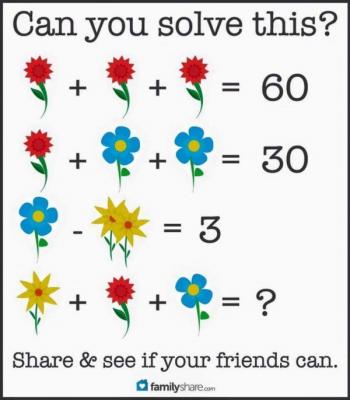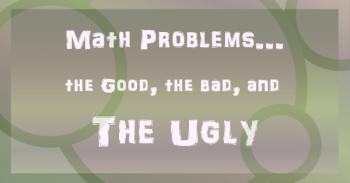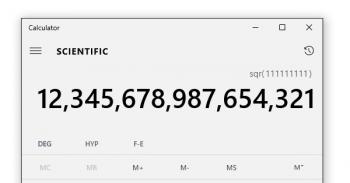Ask Professor Puzzler
Do you have a question you would like to ask Professor Puzzler? Click here to ask your question!
"I noticed that all the perfect squares are either a multiple of 4, or they're one more than a multiple of 4. Is that a rule or something?" ~Wes in South Dakota
Wes, I don't know if it's a rule, exactly, but it's definitely a true statement. Every perfect square is either a multiple of four, or one more than a multiple of four. Would you like me to prove it?
Every integer is either even or odd. That means it's either a multiple of two, or it isn't. If it's a multiple of two, we can write it like this:
2n
If it's NOT a multiple of two, than it must be one more than a multiple of two. That means we can write it like this:
2n + 1
Every integer can be expressed either as 2n or as 2n + 1.
Therefore, every perfect square can be expressed as either (2n)2 or (2n + 1)2.
Now, if you've studied a bit of Algebra, you hopefully know how to simplify both of those expressions:
(2n)2 = 22n2 = 4n2
(2n + 1)2 = (2n + 1)(2n + 1) = 2n(2n + 1) + 1(2n + 1) = 4n2 + 2n + 2n + 1 = 4n2 + 4n + 1 = 4(n2 + n) + 1
Notice the result! The first possibility gives us a multiple of four, and the second one gives us one more than a multiple of four! And since that covers every perfect square, we can conclude that all perfect squares are either a multiple of four or one more than a multiple of four!
DailyMail.co.uk, and the various click-bait sites that copy their content, seem to be a bit confused on the difference between "hard" and "unsolvable." They recently discovered the "flower problem" (which everyone else was talking about four months ago), then they found our explanation of the problem, and posted a fine click-bait article headlined something along the lines of "Problem is so hard even a math teacher can't solve it."

There is a huge difference between something being "hard" and something being "unsolvable."
Let me give you an example:
John can mow lawns at a rate of 1 lawn every three hours. Jane can mow lawns at a rate of 2 lawns every five hours. If John and Jane work together, how many brick walls can they build in ten hours?
This is not a hard problem. It's actually very, very easy. It's very easy to recognize that the answer is "not enough information given." Information about rates mowing lawns doesn't tell us a blessed thing about their wall-building rates.
"Hard" implies that someone will actually spend a lot of time wrestling with the problem. But, in fact, you didn't spend any time at all on that, right? You knew immediately and instinctively that there wasn't enough information to solve it. That wasn't hard.
Here's another problem:
If x + y = 30, find the value of 2x - 3y.
Now this one is a little harder, because it might not be immediately apparent that there isn't enough information to solve the problem. Any first or second year Algebra student, however, shouldn't spend much time on that before they say, "Hey, wait a minute! There are two variables there, and only one linear equation, so I can't find x and y!"
Of course, a problem can be both hard and unsolvable. I used to get (on a regular basis) emails from people all over the world who were convinced that they had found a method of trisecting angles with a compass and straight edge. They spent hours and hours on their solutions - it was hard. And, sadly, despite all their hard work, they were wrong; the correct answer is, "It can't be done." And it has been proven. And the proof wasn't an easy one.
But...the flower problem is not hard.* It's very easy to see why the problem is not possible to solve. If you think you've found a numerical solution, make sure you think through exactly what assumptions you've made about the flowers and their petals (and their stems and leaves, because yes, you've probably made assumptions about those, too!), and then go read our blog post.
Thanks for visiting our site, and make sure you try out our educational games while you're here!
* Having said that the problem is not hard, I have to admit that it's excruciatingly painful to look at the comment sections on sites like DailyMail and realize that even setting aside the fact that you can't solve the problem without making assumptions, most people posting their "answers" don't even know elementary level mathematics and order of operations, and that there are almost as many answers given as there are comments made. So maybe the problem is harder than I thought.
And maybe DailyMail should have titled their article "So hard people think it can be solved." :D
For those who are interested in seeing more "bad math problems" on our blog, click the image below.

"Hi Professor, my algebra teacher multiplied 97 x 103 in her head, and said she "used algebra" to do it. Can you explain what she did? -Anon."
Sure, Anon. There are situations where knowing some algebraic factoring rules can be a big help in doing mental math, and the example your teacher gave is one of those situations.
In order to answer your question, you're going to need to know an algebraic factoring rule called the "difference of squares" rule. If you don't know it, here it is:
a2 - b2 = (a + b)(a - b)
It's easy to see why this is true, by using the distributive property on the right-hand side:
(a + b)(a - b) =
a(a - b) + b(a - b) =
a2 - ab + ab - b2 =
a2 - b2
So to solve 97 x 103 in your head, you need to recognize that 97 is three less than 100, and 103 is three more than 100, which means the following is true:
97 x 103 =
(100 - 3)(100 + 3) =
1002 - 32 =
10000 - 9 =
9991
All of that can be done mentally, without writing anything down on paper, and without using a calculator.
Is this a useful technique? Well, it's only useful if you're multiplying two things that are equidistant from something you know the square of.
I happen to know, for example that 162 is 256. So if someone asked me what 15 x 17 is, I would do this:
15 x 17 =
(16 - 1)(16 + 1) =
162 - 12 =
256 - 1 =
255
And since the only thing I actually did was subtract 1 from 256, I had the answer before you even started reaching for your calculator.
Speaking of 256...since I've done software work ever since I was in high school (back in the 1980s!), and have therefore worked extensively with powers of 2, I have this math fact indelibly imprinted on my brain:
2562 = 65,536
I will occasionally use this fact to freak out my math students. I'll write up on the board something like:
246 x 266 =
And then, while they're still punching that first number into their calculators, I'll finish writing the answer:
246 x 266 = 65,436
How did I do that in my head? Easy! I deliberately chose two numbers that are equidistant from 256:
246 x 266 =
(256 - 10)(256 + 10) =
2562 - 102 =
65,536 - 100 =
65,436
Of course, the "Difference of Squares" rule is not the only algebraic rule that could help us with mental math. Consider the following question:
Find the prime factorization of 1027.
To solve this mentally, you'll need the following rule for "Sum of Cubes"
a3 + b3 = (a + b)(a2 - ab + b2)
I note the following:
1027 =
103 + 33 =
(10 + 3)(102 - 10 x 3 + 32) =
13 x 79
Here's one more example:
Find the prime factorization of 1332.
1332 =
1331 + 1 =
113 + 13 =
(11 + 1)(112 - 11 x 1 + 12) =
12 x 111 =
(22 x 3) x (3 x 37) =
22 x 32 x 37
In practical, real world mathematics, these kinds of "stunts" don't usually gain you much, but they can be useful to math teachers in the classroom. If I'm working with students on prime factorizations, I might deliberately create a "sum of cubes" number so that I can find the factorization quickly in my head, and I'll therefore know if my students have the correct answer, without having to go through the work of doing a factor tree. (Yep, I'm lazy that way!)
"Your blog post about palindromic squaring made me wonder - how many palindromic perfect squares are there?" ~D.
As a quick review for anyone who missed the post you referred to, a palindrome is a number (or word) that is the same forward and backward. For example 121 is a palindrome, because if you write it backwards, it's still 121.
So how many perfect squares are there that are palindromes? 121 is one example, but surely there must be others?
Yes. In fact, there are infinitely many perfect squares that are palindromes. Would you like a proof?
Let x = 10n + 1.
Then x2 = (10n + 1)(10n + 1)
x2 = 10n(10n + 1) + 1(10n + 1)
x2 = 102n + 10n + 10n + 1
x2 = 102n + 2·10n + 1
Written in base ten notation, this number would have 2n + 1 digits. The (n + 1)th digit would be 2, the first and last digits would be ones, and all the other digits would be zeroes. Since n+1 is halfway between 1 and 2n + 1 (note that n + 1 is the average of 1 and 2n + 1), the digits "mirror" each other, and the number is palindromic. This works for every positive integer n, which means there are an infinite number of palindromic perfect squares. Just so you can see an example of this, let n = 4. Then we have:
x = 104 + 1 = 10001.
100012 = 100020001, which is a palindrome.
Of course, these all take the same form; a one at the beginning and end, a two in the middle, and everything else zero. You can find ones that take different forms:
2122 = 44944
1011012 = 10221412201
1111000011112 = 12343210246864201234321
And I submit (without proof) that for every form you find, you can create infinitely many palindromic perfect squares by inserting zeroes between the digits of the number you square.
Luigi from Brooklyn writes, "My brother told me that 111,111,111 multiplied by itself is 12,345,678,987,654,321. Is that true or is that just another lie?"
Well, Luigi, it sounds to me like you and your brother have some trust issues! Does he often lie to you about math problems?
I can imagine you might have tried doing the multiplication on a calculator, and found that the calculator didn't have enough place values to display the result. Probably you got something ugly in scientific notation. There are calculators out there that will display enough digits to give you the answer. For example, the calculator on my computer will show the complete answer:

Hopefully that settles the dispute to your satisfaction. Of course, you don't need a calculator to do this; you can multiply it out by hand quite readily:
111111111
x 111111111
---------
111111111
111111111
111111111
111111111
111111111
111111111
111111111
111111111
111111111
-----------------
12345678987654321
By the way, the title of this blog post is "Palindromic Multiplication," and there's a reason for that. A palindrome is a number (or word) that is the same both forward and backward. For example, "racecar" is a palindrome because, if you spell it backwards, you still have "racecar." This is an example where we squared a palindrome, and the result is another palindrome.
This doesn't always happen; it happens in this case because the multiplication doesn't result in any carrying (you can see from my multiplication above that the most we ever have added together in one column is 9 ones; if we had more than 9 ones, we'd have to do some carrying, which might mess up the palindromic nature of the result. So if we keep the digits small (mostly ones, zeroes, and maybe some twos), we may be able to find other palindromic results.
For example, multiply 121 by itself:
121 x 121 --- 121 242 121 ----- 14641
But watch what happens if we try 131:
131 x 131 --- 131 393 131 ----- 17161
This one is not a palindrome. Do you see why? In the third addition column we have 1 + 9 + 1, which results in a carry, and that throws off the symmetry of the result.
I know this is a lot more than you asked for in your question, but I think palindromes are very interesting, so I couldn't resist telling you a bit about them.
And finally, I leave you with the words of Napoleon, after he was exiled to the island of Elba: "Able was I ere I saw Elba." Now spell that backwards, and see what you get. :)

